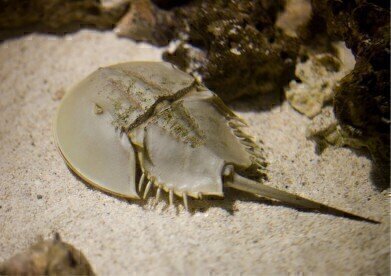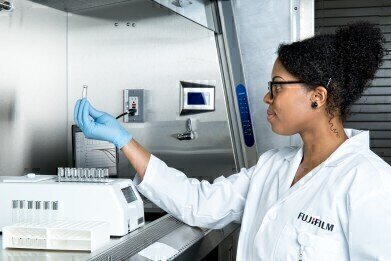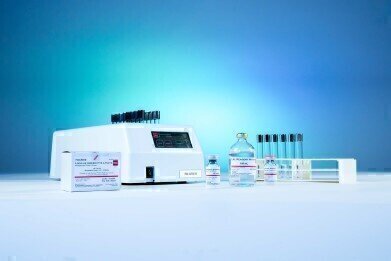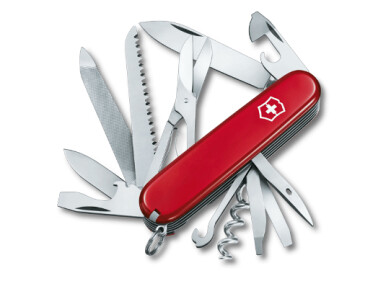-
 The Atlantic horseshoe crab has a special immune system. If the blood of this ancient species comes into contact with endotoxin, it forms a clot around the pathogen which prevents further infection of the wounded area. Source: FUJIFILM Wako Chemicals Europe GmbH
The Atlantic horseshoe crab has a special immune system. If the blood of this ancient species comes into contact with endotoxin, it forms a clot around the pathogen which prevents further infection of the wounded area. Source: FUJIFILM Wako Chemicals Europe GmbH -
 Limit value tests (BET/LAL) are used to preclude contamination during manufacture. They are based on a special factor harvested from the blood of the horseshoe crab. Source: FUJIFILM Wako Chemicals Europe GmbH
Limit value tests (BET/LAL) are used to preclude contamination during manufacture. They are based on a special factor harvested from the blood of the horseshoe crab. Source: FUJIFILM Wako Chemicals Europe GmbH -
 FUJIFILM Wako offers the buffer as a separate solution for adding to untreated LAL reagents. In addition, the buffer is already included in a number of endotoxin-specific reagents. These include ready-to-use test kits. Source: FUJIFILM Wako Chemicals Europe GmbH
FUJIFILM Wako offers the buffer as a separate solution for adding to untreated LAL reagents. In addition, the buffer is already included in a number of endotoxin-specific reagents. These include ready-to-use test kits. Source: FUJIFILM Wako Chemicals Europe GmbH
Laboratory products
Tracking Down Pyrogens: Unique ES Buffer Enables Specific Detection of Endotoxin with all Common LAL Reagents
Mar 16 2022
Quality control of pharmaceutical and medical products
Before market release, medications and medical products as well as process materials in the laboratory and clinic, must be free of bacterial endotoxins to ensure the safety for human use. Special limit value tests (BET/LAL) are used to preclude contamination during manufacture. In order to eliminate interferences, FUJIFILM Wako Chemicals Europe GmbH provides a unique endotoxin-specific (ES) buffer for untreated LAL reagents and formulated for all common detection methods. While all LAL reagents manufactured by Fujifilm Wako are already endotoxin specific, the buffer can make commercial reagents endotoxin specific as an additive. This allows the determination of the actual endotoxin concentration in the sample. A change to other test systems is not necessary.
Coagulation factor sourced sustainably from the blood of the primeval Horseshoe Crab
Endotoxins resist many standard sterilisation methods. If they get into the bloodstream of humans or animals, they can cause a severe inflammation reaction and fever. However, the Atlantic horseshoe crab (Limulus polyphemus) has a very special immune system. If its blue blood comes into contact with endotoxin, as an immune response it forms a clot around the pathogen which prevents further infection of the wounded area. This is done by a special blood factor which forms the basis of the bacterial endotoxin test (BET) or limulus amoebocyte lysate (LAL) test. “The test is intended to prevent contamination in use on humans and animals since pharmaceutical products can become contaminated during cleaning, production, or packaging, for example due to insufficient cleaning of processing equipment, or contaminated starting materials like reagent water,” reports Yannic Werner, Sales Manager for Laboratory Chemicals at FUJIFILM Wako Chemicals Europe GmbH. However, untreated LAL reagents also react to fungus cell wall components - more precisely, to (1→3) β-D-glucan (beta-glucan) - likewise causing the coagulation cascade. This leads to a false positive BET result. The ES-buffer blocks the activation cascade of fungus and permits only that of gram-negative bacteria.
ES Buffer Prevents False Positive Results
The buffer is a solution that resists pH change when an acidic or alkaline substance is added. If endotoxin is present, only its activity is permitted, causing a coagulation reaction. When the proclotting enzyme is activated, it is converted to its active form, which splits the coagulogen into an insoluble clot gel, thereby increasing the turbidity of the solution. This action makes it possible to observe qualitative or quantitative effects, proving the presence of endotoxin as well as the amount of it present. The test itself can be done by one of three methods: gel clot, kinetic turbidimetric (KTA), or kinetic chromogenic (KCA). Each pre-prepared ES buffer vial contains solution for the reconstitution of 6 mL of reagent. FUJIFILM Wako offers the buffer exclusively as a separate solution for adding to untreated LAL reagents. They can simply be used with endotoxin-free water without the need for further additives or a buffer for the BET tests.
Digital Edition
Lab Asia 31.6 Dec 2024
December 2024
Chromatography Articles - Sustainable chromatography: Embracing software for greener methods Mass Spectrometry & Spectroscopy Articles - Solving industry challenges for phosphorus containi...
View all digital editions
Events
Jan 22 2025 Tokyo, Japan
Jan 22 2025 Birmingham, UK
Jan 25 2025 San Diego, CA, USA
Jan 27 2025 Dubai, UAE
Jan 29 2025 Tokyo, Japan
.jpg)

















